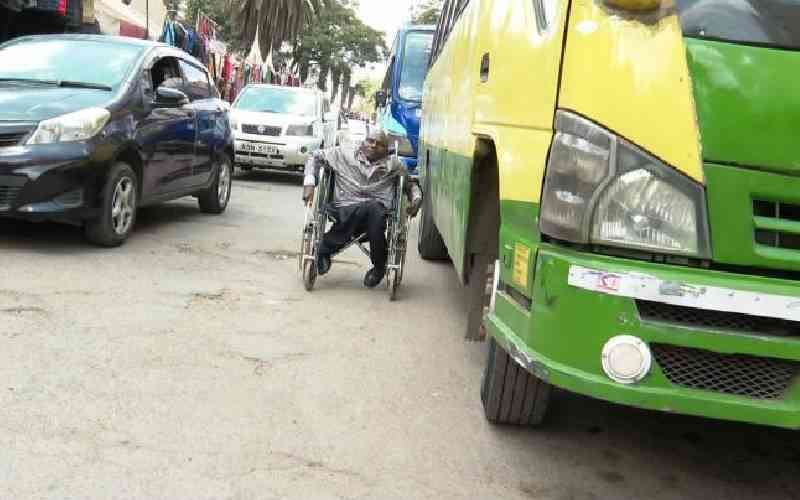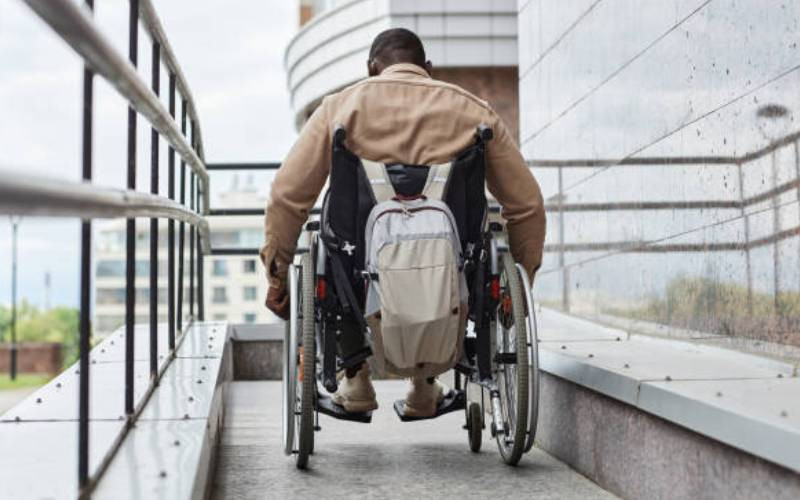
It is yet another morning when John Oguro, a resident of Kariobangi in Nairobi, wheels his way to work. To the ordinary pedestrian, his struggles may go unnoticed as his mobility appears to be catered for in one way or the other.
But the distance between Oguro's home and place of work is riddled with many challenges: Despite having a guide for his wheelchair, the auditor has to manoeuvre dilapidated roads within his estate to the bus stop where he catches public means to town.
He pensively waits at the bus stop alongside other passengers. He is not guaranteed of a seat as he waits for about 20 minutes before a 14-seater makes its way to the stage.
Oguro is the last passenger to board and has to be assisted by the tout and his handlers who fold the wheelchair before carefully forcing it to fit in the tinny space right behind the drivers' seat.
"This is what we go through as people living with disability especially those who use wheelchairs as mobility equipment," says Oguro.
Accessibility of the transport infrastructure is critical for the inclusion of persons with disabilities. However, most public service vehicles are not spacious enough to accommodate people with physical disability and their mobility equipment.
More often than not, they are forced to incur an extra cost in transportation as some of them opt for the more accommodative taxis.
"Not everybody will be comfortable sitting next to you in the vehicle knowing that the wheelchair is likely to stain their attire in the morning or make them uncomfortable," explains Oguro.
- Former Health PS Tum defends role in Sh3.7b mosquito net scandal
- Delayed launch of clinical guidelines causing needless deaths
- Controversy on Sh3.7b net scandal deepens
- MoH directs counties to adopt integrated model in fight against diseases
Keep Reading
Experts argue that while accessibility is dependent on the ability of the built environment to recognize the diversity of the needs of people with disabilities along the travel chain, safety is dependent on the transport system's ability to protect vulnerable users from accidents and injuries.
Therefore, safe mobility entails the ability of persons with disabilities to independently use a mode of transport. It is a critical facet of exclusivity and accessibility that cannot be overlooked, but is that often the case for people like Oguro?
Similarly, infrastructure depending on their design can enable or impede access and participation of this group of people.

The concept of universal design is critical in promoting accessibility, safety and affordability in transport infrastructure. Some of the key components of this design in the transport system include; ease in boarding and disembarking vehicles, securing passengers and their mobility equipment and ease in inputting the destination.
For the able-bodied, mobility and access to public services is almost automatic, they can walk out of their homes, board matatus, climb long staircases to offices and, generally go anywhere they wish.
For those with disabilities every day is fraught with challenges that requires precision in planning. Where they go and how they get there is akin to manoeuvring an urban jungle.
The 'profit-oriented' public transport, being a private sector, has indeed, been faulted for failing to adequately provide for people living with disability.
Urban planning experts argue that there is need for clear standard for non-motorized transport infrastructure to ensure accessibility.
Dr Romanus Opiyo, an urban planner and lecturer, Department of Urban and Regional Planning, University of Nairobi says the size and busy nature of cities is such that "we need to have a provision of three metres for walkways and two metres for cycle paths. The current existing disparity in terms of walkways and cycle paths across cities is unacceptable."
Then there is the glaring failure to factor in clear footpaths on some major roads in the capital city like the newly commissioned Nairobi Expressway. Some of its sections have obstructed footpaths making it hard for pedestrians to move safely and the situation is even worse for persons with disabilities.
"There are two things to take consider; one is connectivity. Like, where do these footpaths connect to because when giving an infrastructure you must have an idea of the connectivity in terms of who you are providing the facility to," explains Dr Opiyo.
He adds that some baseline or a travel survey can give an indication of the "popular destination so that you connect this particular infrastructure or pedestrian facilities with the popular destinations."
The baseline survey should consider the mobility needs of people to ensure it aligns with the universal design concept.
Oguro is often competing with other motorists within town for space, much as ramps have been erected in some parts of town to ease mobility for persons' living with physical disability, movement in some parts remains a nightmare for those using wheelchairs and crutches.
"Some ramps are very steep and that makes it hard for anyone living with physical disability to use them independently," says Oguro.
Another person living with physical disability, Isaack Mwita says "some pavements are not 'disability friendly', it is often a struggle to use them considering that I must use my crutches to move around."

A guide plays a critical role in ensuring the safety of wheelchair users like Oguro, especially when crossing busy streets where motorists show no regard for other road users.
"Somebody like John can easily be quashed in between vehicles considering his small stature, luckily I am always around to help him manoeuvre the buses because the drivers can't see him," said Oguro's handler.
According to the 2019 census report on disability, 2.2 per cent of Kenyans translating to 0.9 million people live with some form of disability. To ensure they all live a dignified life despite their disability, enforcing the principle of universal design in all aspects guarantees them smooth mobility.
"The built environments continue to present multiple barriers to people with disabilities. Heavy traffic, absent or uneven footpaths also inhibit our mobility," said the National Council For Persons With Disabilities Executive Director, Hassan Harun.
The public's lack of knowledge on matters of accessibility and mobility continues to 'disable disability'. For instance, every city or town has parking spaces designated for person's living with disability, however, these spaces are often abused by people who do not have parking permits for the reserved bays.
Accessibility is a vital component to leading a normal life for those with mobility issues or those who have disabilities that make it difficult to gain access to certain public spaces without assistance.
Accessibility of buildings has seen regulations put in place to accommodate people living with different types of disability. For instance, in Nairobi zoning regulations stipulates that a building with more than five floors should have an elevator.
Dr Opiyo reckons that "to appreciate the universal access to buildings there are requirements that cannot be ignored providing at least a ramp whether it is a first or second-floor building to facilitate accessibility."
"From the concept of universal design, at least we are headed somewhere. Most modern buildings now are accessible, unlike before when I would be forced to wait outside some buildings in order to be served due to inaccessibility," said Harun.
 The Standard Group Plc is a multi-media organization with investments in media platforms spanning newspaper print
operations, television, radio broadcasting, digital and online services. The Standard Group is recognized as a
leading multi-media house in Kenya with a key influence in matters of national and international interest.
The Standard Group Plc is a multi-media organization with investments in media platforms spanning newspaper print
operations, television, radio broadcasting, digital and online services. The Standard Group is recognized as a
leading multi-media house in Kenya with a key influence in matters of national and international interest.











